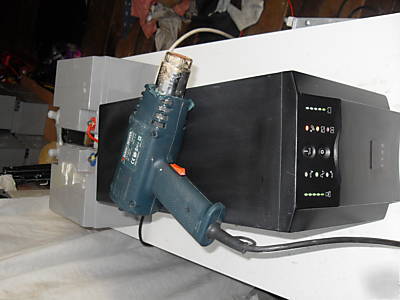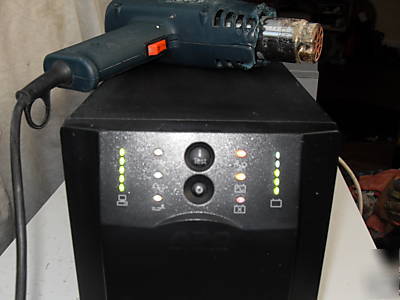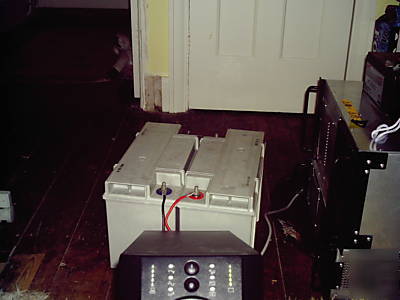Reduce Scrapping and Smelting, Promote Component Reuse > Electric Powered
> Woodworking
> 1500W sine wave inverter charger solar wind turbine
1500W sine wave inverter charger solar wind turbine
95% efficient 980w 1.5 KVA surge pure sine wave inverter battery charger. with built in automatic transfer switch ATS
This is not like the cheap seriously inefficient modified sine-wave inverters, this inverter gives a pure sine-wave output which stops problems such as PSU buzzing and audio or video interference on sensitive equipment. So perfect for use with sensitive electronic devices such as:
TV's, DVD video CD players Game Consoles, Computers.
We used a similar inverter in the evenings for watching the television and DVD plus the CD player as the large inverter we have wasted power, when it has low current draw and when on standby. Its also very quiet running. it also has an automatic cooling fan. the inverter is still big enough to run smaller kettles and microwave ovens.
The inverter gave clear crisp picture on the television. With the modified sine wave inverter the picture was grainy and had fuzzy lines plus the DVD player kept stalling.
It is 24v DC input 240v AC 980w continuous output, 1500w surge, plenty enough for the television and DVD player etc.
Even some of the more expensive sine wave inverters only get 85% efficiency, so we didn t want to waste over 10%+ of our difficult to obtain green electricity
It can also charge the batteries,from a generator, so if the solar panels or wind turbine are not producing much power for a while it can be used to fully charge the batteries to keep them in tiptop condition on optimum float charge (13.5v - 13.8v per battery). This float charging is ideal level for batteries not to deteriorate and protect expensive battery banks. when connected to a generator while charging battery bank, it will also smooth out the power from the generator to the load (as many generators powering sensative electronic items is not ideal, with grainy/lines on television and surges in power) it will also instantly switch to the inverter battery power when the generator is shut down, with no break in power ATS.
It also has LED status display with load and battery bar-graphs. One shows you the percentage state of charge of your batteries with a line of green LEDs (all on = fully charged, one on=low batteries), it also shows you how much power you are using with another line of LEDs. I found the battery level indicator good and used it to monitor and not let battery drop to low. As it will shorten the life of batteries. Also has low battery cut out to protect from deep discharge
There are other LED for On Line: On Battery: Replace Battery: and Overload Indicators
It came from a backup power supply to keep the server and computers going in a power cut/blackout, was a very expensive bit of kit when new.
The photos with the 1400 watt hot air stripper, show the inverters capabilities. the inverter has a warning beeper and red overload light (light right of the on/test button) and the inverter will safely switch itself off if overloaded for to long. the line of fully lite LEDs on the left show the amount of load on the inverter.
The control panel can be removed from the inverter and if the cable extended (which I was planning with telephone cable) could be used remotely leaving the inverter with the batteries in the shed for example and the control panel in the house. It comes with all nessesary power leads. and battery bank connection lead.
Quality item, fast delivery.Great communication and very helpful seller.
2250w Pure Sine Wave Inverter Charger, turbine / solar (#200276677648)
950w Pure Sine Wave Inverter charger solar Wind turbine (#200279615909)
2250w Pure Sine Wave Inverter Charger, turbine / solar (#200276677662)
fab seller - very helpful and obliging - excellent packaging/postal rates..A++++
2250w Pure Sine Wave Inverter Charger, turbine / solar (#200272378500)
950w Pure Sine Wave Inverter charger solar Wind turbine (#200275392668)
980w Pure Sine Wave Inverter charger solar Wind turbine (#200296831253)
second one i've bought superb..
670w Pure Sine Wave Inverter charger solar Wind turbine (#200288534430)
also found some intresting artical (below) regarding the different desig inverters, this inverter is the heavy iron core type.
1. High frequency conversion units which is typical of the design that you will find in inverters that are manufactured overseas in countries like Taiwan and China.
High frequency units take the incoming DC and will step up that voltage to approximately 200 volts DC through a high frequency DC to DC converter circuit and then will take the 200 Volts and will wave shape it using a using a device called a high voltage H-bridge. The high voltage H-bridge is basically a group of field effect transistors that are arranged in such a way as to form the necessary half cycles that create the sine wave at the frequency required.
By utilizing high frequency, the need for a large iron core output transformer is eliminated and much smaller transformers can be used. As a result of this, high frequency inverters tend to be much lighter but do have a lower surge capacity because they lack the fly wheel effect found in heavy iron core output transformer based inverters.
The technology was originally developed for the space program where weight is a major consideration. This type of inverter tends to be less expensive to manufacture and are considered a lighter duty type of product than their US made low frequency counterparts.
2. Low frequency conversion units that are typical of US designed inverters.
As mentioned above these inverters use large heavy iron core transformers that tend to provide a flywheel effect which yields a much greater surge capacity than do high frequency inverters.
Low frequency units take the incoming DC (direct current) and converts it into AC (alternating current), using a multi-vibrator or microprocessor based circuit. This low voltage is fed to an iron core step up transformer which converts the 48 volts AC into 240 volts AC.
Wave shaping and the increased current that is needed to drive the transformer is performed again by an H-bridge which is a group of field effect transistors that are arranged in such a way as to feed high current pulses to the primary windings of the transformer at precise moments of each wave form half cycle.
The transformer converts the lower voltage which was fed to its primary windings into 240 Volts AC at its secondary windings using simple transformer step up principles involving correct ratio, converting 48 Volts AC to 240V AC. This type of inverter is considered more durable than their high frequency counterparts and have a much higher surge capacity.
You might be asking why anyone would choose a high frequency inverter when low frequency units are more durable ? The answer is cost.
Low frequency units tend to cost two to five times more than do high frequency units, another consideration is of course the difference in weight. For example a typical 2000 watt high frequency based inverter may weigh 13 Lbs, where a typical low frequency inverter can weigh as much as 50 Lbs.
Inverters are available as inverter units only, or may have additional circuits added that allows them charge batteries when an external AC source is fed into the inverter. This type of configuration is know as an inverter/charger. In addition to the charger circuit, these units will typically include a device known as an AC transfer switch.
These added devices allows the inverter to charge your batteries from a generator or utility AC power source and passes the AC power through the inverter to your loads, allowing you to operate your appliances while the batteries are being charged. As soon as the external AC power is turned off or is removed from the inverter, the inverter/charger automatically returns to functioning as an inverter, outputting its own AC power. Another advantage that an inverter/charger with transfer switch offers is that it can function as a highly reliable automatic power backup unit
When the utility company is operating normally the inverter/charger passes the utility company power through its internal transfer switch to your appliances and maintains a charge on your battery bank. As soon as the utility power fails, the inverter automatically stops charging the battery bank and begins producing its own AC power which is passed on to your appliances through its internal AC transfer switch.
When the utility power returns the inverter goes back to charging the batteries and again passes the utility power though the transfer switch to your appliances. Most inverter/chargers switch from utility power to inverter power and back again so fast that most of your appliances will not miss a beat.


